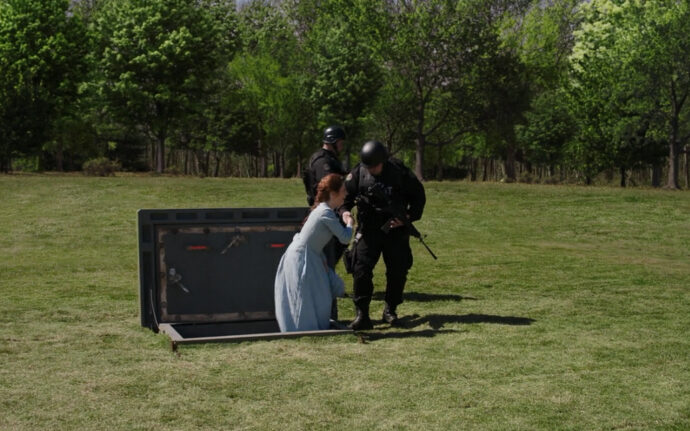We aren’t meant to dwell on the theological particulars of the bunker-bound doomsday cult from which Kimmy Schmidt and three other women were rescued in the new Netflix series The Unbreakable Kimmy Schmidt. (In fact, good luck if you decide to try. There’s something about Jesus’ crazy stepbrother Terry, and Gosh’s son Jeepers, and the apocalypse happening because people are dumb. Apparently Durnsville, Indiana doesn’t have any systematic theologians.)
That’s okay, though, because the cult’s claims don’t really need to be very persuasive. After all, they don’t rely on persuasion to attract adherents. The Spooky Church of the Scary Apocalypse – of which Rev. Wayne Gary Wayne is the CFO – manages to attract exactly one voluntary member. The rest are kidnapped and held in a bunker by Rev. Wayne, who… well, in order to avoid giving anything away, let’s just say he’s working an angle.
So what is the cult doing exactly, beyond explaining how the traumatized optimist Kimmy Schmidt got to New York with nothing more than a backpack full of cash and a middle school education?
Well, a good place to start might be the equally ridiculously named fake religion from the elder Tina Fey/Robert Carlock creation, 30 Rock. Kenneth Parcell, you may recall, belonged to the Eighth Day Resurrected Covenant of the Holy Trinity. As we learn in the episode “Fighting Irish,” the church is located in the basement of a Cuban restaurant. Its leader is the creepy Reverend Gary – no relation, presumably, to Kimmy Schmidt’s Wayne Gary Wayne—who says things like “The stench of rotten flesh fills the air! Judgment is upon us all!”
But the most interesting parallels don’t have to do with the two shows’ cartoonish fire-and-brimstone preachers named Gary. Rather, they have to do with two followers: Kenneth and Kimmy.
For starters, both are oddly out of time, but in different ways. Kenneth, it is strongly implied, is immortal – or at least, he was born in the 1780s and lives, without visibly aging, until the time of rocket cars. Despite having lived through slavery, the US Civil War, both World Wars, and pandemic flu, he declares his two favorite things to be people and television. In contrast to the unkillable Kenneth, who has an overabundance of history, the unbreakable Kimmy has too little. She has entirely missed the aughts as experienced by the outside world, having spent it in the bunker turning a mystery crank, eating rocks, and playing imaginary catch with the other mole women.
But how does this lost decade cause misunderstanding between Kimmy and the people she meets? Does she offend someone when she asks for directions to the Twin Towers? Does she read the paper and say “What the fudge? We were at war with Afghanistan?” Nope. It’s her clothes, her musical references, her wearable technology, and her outdated slang that mark her as off. She plays cassettes on a Walkman. She doesn’t know what a selfie is, or how to text, or the words to Katy Perry’s “Firework.” Some who meet her in New York think she’s clueless because she hails from the middle of the country. (When Kimmy expresses a desire to go “someplace cool, like Club Bombay from Moesha,” her roommate Titus replies, “Whoo, things are behind in Indiana.”) One by one, though, the supporting cast gradually learn that she is one of the famous Indiana “mole women” – the media’s nickname for the group, and an identity that Kimmy prefers to hide.
But what about her optimism, loyalty, and sincerity? And what about Kimmy’s ability to call BS on some of the more vapid trends of 2015? (SoulCycle groupies, you are warned.) Are those traits likewise relics of a pre-aughties world? For that matter, what about Kenneth Parcell? He’s a flyover state native too, hailing from Stone Mountain, Georgia. He attended a Bible college. (He’s hundreds of years old.) Does his optimism, cheerfulness, and desire to do his best belong to a lost past as well—along with Kimmy’s cassette tapes, the 90s, Indiana, Georgia, scrunchies, and preachers named Gary?
In The Future of Nostalgia Svetlana Boym discusses the remarkable etymology of the word “nostalgia.” It looks like it might be an ancient Greek concept, since the root words are Greek: nostos, meaning “return home;” and algos, or “longing.” In fact it’s a modern word—and thus, in Boym’s words, only “nostalgically Greek.” And fittingly so, because it describes a thoroughly modern phenomenon, described by the Swiss medical student Johannes Hofer in the 17th century (about a hundred years before Kenneth Parcell was born.) Evidently doctors of that time saw patients whose affliction was a longing for home. To treat this ailment, doctors prescribed opium, leeches, and trips to the Alps. Notwithstanding these interventions, nostalgia has endured. It is, Boym writes:
a symptom of our age, a historical emotion… Nostalgia and progress are like Jekyll and Hyde: doubles and mirrors of one another…. [It] appears to be a longing for a place but is actually a yearning for a different time – the time of our childhood, the slower rhythms of our dreams. In a broader sense, nostalgia is a rebellion against the modern idea of time, the time of history and progress. The nostalgic desires to obliterate history and turn it into private or collective mythology, to revisit time as space, refusing to surrender to the irreversibility of time that plagues the human condition.
Kimmy Schmidt has no desire to return home to Durnsville, Indiana. When she finally does so, it is only because she must testify in Rev. Wayne Gary Wayne’s trial. But the appeal of The Unbreakable Kimmy Schmidt may be in the ways it evokes longing for a kind of home, and a kind of past.
I don’t mean that anyone actually wants to relive the 1990s, or to be victim of religious abuse and come out stronger for it, or to buck sociological trends by ditching the big city for a town like Durnsville, Indiana. But I do think many viewers derive pleasure from consuming — in Jean Baudrillard’s words – the hyperreal versions of all these things, their more-real-than-real representations that make for good binge-watching.
It’s like the Epcot World Showcase of the fairly recent past, where the 1990s are nothing but high-top fades and shortall dresses, preachers are fascinatingly sinister doomsday predictors, and people in Indiana are all dimwitted but goodhearted. And we haven’t yet been overcome by our own technology. And maybe the first fifteen years of the twenty-first century never happened. And maybe you and I are just moments away from meeting an irrepressible optimist, who will help us believe in ourselves and others, and will inspire us to do our best.





